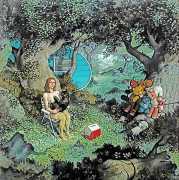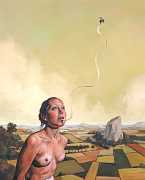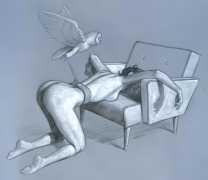
Calling his surreal paintings ‘suspended moments’, Erik Thor Sandberg captures ongoing narratives that exist before and after the scene in question. Whether it’s a towering skeleton consuming flesh or a fairytale-like jaunt between fantasy creatures, Sandberg’s paintings offer both whimsy and unsettling spectacle.
A statement on his website expands on this duality: ‘How often the disturbing and the grotesque capture the viewer’s gaze before the beautiful! Yet, beauty, eternally appreciated, remains an essential component of my work as it contrasts the unsettling and unsightly elements of these imaginary worlds that hinge, unsettlingly, on the verge of our own.’
Sandberg approaches each composition as if it were a conversation between the artist and the viewer. The dialogue thus generated by his work always questions and attempts to define human identity. Using symbolism both established and personal, Sandberg creates narratives without definitive beginnings or ends; he captures pivotal moments and isolates them from time. Upon these suspended moments, he abstains from casting judgment and rather, empathises with the figures that are often transfixed by self-wrought disaster.
‘I use the human form as a metaphor to help convey whatever the message for a particular work might be,’ he explains. ‘If a figure is broken or misshapen then the idea or notion that they represent is somehow flawed as well. I draw a lot from old allegorical imagery and iconology that made use of the same structure for its narratives. It is also why a good deal of the figures in my paintings are female. I looked at very early representations of vice and virtue all the way back to Prudentius. All of the vices and virtues in his poems were female because the Latin words that represented all of these abstract notions were feminine. I kind of liked sticking to that translation of the text to physical incarnations. The figures that strayed from that gender assignation were the vices that I felt connected to the most, and those I made male.’

























































































